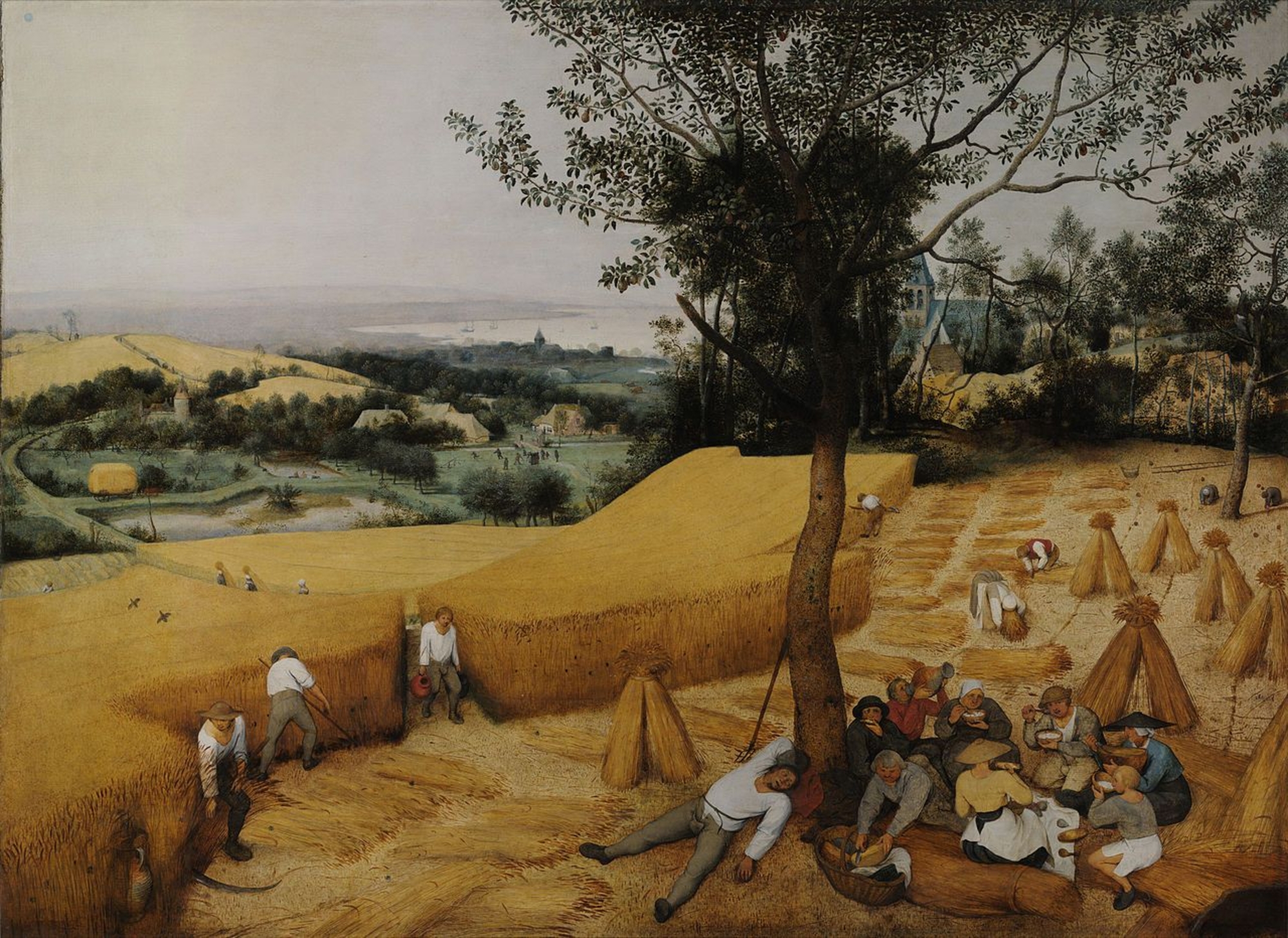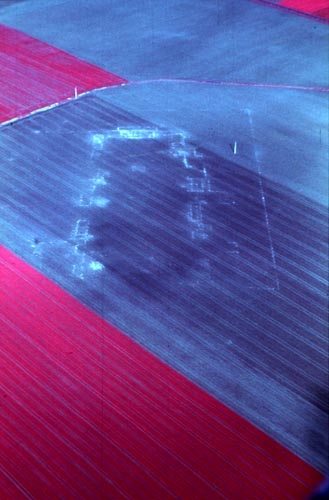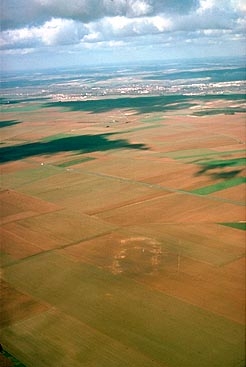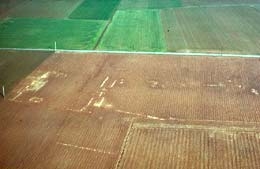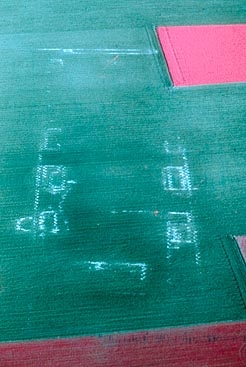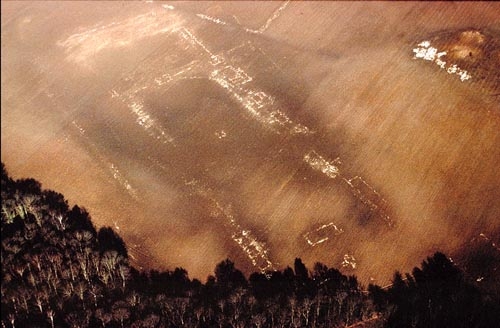- Home
- Discoveries
- Gallo-Roman settlements
- The Gallo-Roman villa
The spectacular contribution of aerial archaeology
For a long time, the top specialists thought that in Gaul, especially northern Gaul, Gallo-Roman civilization was essentially — even exclusively — urban. Even the famous Guizot, writing about the Gallo-Roman countryside, said that it was "cultivated […] but not populated". The few traces of ancient foundations were nearly always thought to be the remains of a vanished "city", even for a small villa like at Marca, near Cambron (Somme). Prior to aerial prospecting, no villas in northern Gaul were known. Flyovers have revealed hundreds, often with annexes, sometimes outlined with a crispness that resembles an architect's sketch! For the conquering Roman, of course, the city — or at least the capital of the civitates — was the central administrative, political, business, and leisure structure. It was even said to be a civilization of leisure!
It is clear that it could not have existed without a well-exploited countryside. We should have thus expected to find rural farm structures — i.e. villas — from the air. The first surprise was that we found so many, and the second was that we identified huge architectural ensembles, astonishingly stereotypical, straight across all the rich wheat fields of Gallia Belgica.
A Gallo-Roman villa, the so-called "town of Marca", at Cambron (Somme). The frost has revealed its foundations and, on the right, the location of a quarry that was used for its construction.
False-color infrared reveals the layout of a very characteristic Gallo-Roman villa with long rectangular courtyards. Warfusée-Abancourt (Somme).
But what is a Villa?
A Gallo-Roman villa is not the same thing that we would call a "villa" today. Curiously, the term was already the source of confusion in Antiquity, as we can see from the discussion of its meaning in Book III of De re rustica by Varro. . It turns out that a dwelling — sumptuous or not — can only be considered to be a "villa" when "it is the center of a rural domain that is large and well cultivated" (fundus). In principle, a villa is isolated in the countryside.
It is simply a large agricultural structure in the middle of its fields, what we would call a "large farm" today. Varro even specified, jokingly, that it should "have donkeys, cattle, hay to be dried, granaries for the harvest, etc.".
Nevertheless, it appears that the term was mainly used for the richest of these establishments, particularly around Rome (S. Agache 1999).
Pliny the Elder ironically talked about "these luxurious villas … where there was more to sweep than to plow". In terms of Gaul, the term "villa" only appears in the history of the wars of 21 and 70 CE related by Tacitus.
Caesar never used this word. He spoke of aedificia. For him, the word "villa" could not be used to designate a "barbarian" structure, but only a sophisticated, "civilized" habitation, i.e. a rural establishment in compliance with Roman norms in its design and in the perfectly geometric layout of both the overall structure and the master residence.
The villa obeyed the architectural rules of symmetry, and introduced the use of masonry, at least in its foundations — which was completely new for Gaul. In short, as soon as the aedificia were built in line with (more romanorum), they became villas, marking the influence and the control of Rome over the conquered provinces.
Here, they are the very foundation of Gallo-Roman civilization and the systematic cultivation of the land. Certain archaeologists make very free use of the term "villa", and consider any contained area in the fields where one finds roof tiles, ceramic shards and coins to be a villa. The discovery of geometric foundations and construction stones are more interesting, even if, once again, they do not necessarily signify the location of a villa. They may be the vestiges of a simple locus, a barn, a sanctuary, or even a vicus.
Aerial photographs often reveal a homogenous, consistent set of foundations organized geometrically around a sophisticated residence, which is characteristic of a villa. Nevertheless, only an excavation can furnish indispensable information about its date and the various stages of its reorganization.
A Gallo-Roman villa isolated in the middle of large fields of wheat. Its layout is identical to the one at Warfusée (Somme). Cappy (Somme).
The large Gallo-Roman villa at Clairy-Saulchoix (Somme). Here it has appeared following plowing, which has rendered the lines of its foundations visible.
The same villa, under different atmospheric conditions and against the light. Only the dark areas, a result of the collapse of the adobe walls, give away the location of the various structures.
The overall layout of the major villas
Aerial prospecting has revealed that almost all of the great villas in Picardy, Artois, and a large part of northern Gaul had sophisticated, perfectly orthogonal layouts, and that they were impressively large.
This is a crucial discovery, because it brings to light previously poorly-understood facts. Of course, Belgian archaeologists were able to establish the complete layout of an immense, perfectly rectangular villa at Anthée (near Namur), with a host of buildings lining the central courtyard.
It was thought that this structure had no equivalent, and it was described as a half-agricultural, half-industrial villa, with "workers' housing" arranged around a 500-meter-long courtyard. We now know that this is the type of establishment that aerial archaeology has shown to be the rule throughout northern France.
Infrared view of a large Gallo-Roman villa at Martainneville (Somme).
Large Gallo-Roman villa whose layout is nearly identical to the one at Warfusée-Abancourt Sud. Cappy (Somme).
Large Gallo-Roman villa, typical for northern France, Estrées-sur-Noye (Somme).
